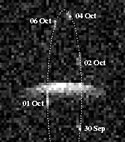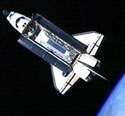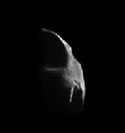
Image credit: Cornell
According to researchers from Cornell University, binary asteroids – where a small asteroid orbits a larger one – are actually pretty common in Earth crossing orbits. In fact, they think that gravitational interactions with the Earth might actually help to cause the arrangement. The researchers estimate that 16% of asteroids larger than 200 metres in diameter have a companion – so far they’ve found five using two of the world’s largest radio telescopes.
Binary asteroids — two rocky objects orbiting about one another — appear to be common in Earth-crossing orbits, astronomers using the world’s two most powerful astronomical radar telescopes report. And it is probable, they say, that these double asteroid systems have been formed as a result of gravitational effects during close encounters with at least two of the inner planets, including Earth.
Writing in a report published by the journalScience on its Science Express web site (April 11, 2002), the researchers estimate that about 16 percent of so-called near-Earth asteroids (NEAs) larger than 200 meters (219 yards) in diameter are likely to be binary systems, with about a three-to-one relative size of the two encircling bodies. To date, five such binary systems have been identified by radar, says lead researcher Jean-Luc Margot, an O.K. Earl postdoctoral fellow in the Division of Geological and Planetary Sciences at the California Institute of Technology.
Margot, who at the time of the observations was a research associate in the planetary studies/radar group at the National Science Foundation’s (NSF) Arecibo Observatory in Puerto Rico (managed at Cornell University), says that theoretical and modeling results show the binary asteroids appear to be formed extremely close to Earth — within a distance equal to a few times the planet’s radius (6,378 kilometers or 3,963 miles). “The fact that one out of every six large NEAs is a binary and that they typically survive on the order of 10 million years, implies that these close encounters must happen frequently compared to the lifetime of the binary asteroids,” says Margot.
The Science article, “Binary Asteroids in the Near-Earth Object Population,” is coauthored by Michael Nolan, research associate at Arecibo; Lance Benner, Steven Ostro, Raymond Jurgens, Jon Giorgini and Martin Slade at the Jet Propulsion Laboratory (JPL); and Donald Campbell, professor of astronomy at Cornell. The observations were made at the 70-meter Goldstone NASA tracking telescope in California and at Arecibo Observatory.
NEAs are formed in the asteroid belt, between the orbits of Mars and Jupiter, and nudged by the gravitational attraction of nearby planets, largely Jupiter, into orbits that allow them to enter the Earth’s neighborhood. Most of the asteroids are the remnants of the initial agglomeration of the inner planets.
Astronomers have long speculated about the existence of binary NEAs, based in part on impact craters on Earth. Of about 28 known terrestrial impact craters with diameters greater than 20 kilometers, at least three are double craters formed by impacts of objects about the same size as the newly discovered binaries. Astronomers also have noted the changes in brightness of reflected sunlight for some NEAs, indicating a double system was causing an eclipse or occultation of one by the other.
In 2000, Margot and his co-researchers, using measurements from the Goldstone radar, found that a small, roughly 800-meter-diameter (half-a-mile) asteroid, 2000 DP107 (discovered only months before by a team from the Massachusetts Institute of Technology), was a binary system. Observations over eight days last October with the much more sensitive Arecibo telescope clearly established the physical characteristics of DP107’s two asteroids as well as their orbit about each other. The smaller object called the secondary, it was found, is about 300 meters (1,000 feet) in diameter and is orbiting the larger asteroid, the primary, every 42 hours at a distance of 2.6 kilometers (1.6 miles). The two asteroids appear to be locked in synchronous rotation, with the smaller always with the same face oriented to the larger.
Since that observation, says Margot, four more binary NEAs have been discovered, all in Earth-crossing orbits and each with a main asteroid significantly larger than the smaller body. “The primary is rotating much faster than most NEAs in all five binaries that have been discovered,” says Cornell’s Campbell. The Science Express article speculates that the most likely way the binaries are created is by close encounters of asteroids with the inner planets Earth or Mars. Of the five binary NEAs discovered to date, none has an orbit that brings it as close to the sun as Venus or Mercury.
NEAs, basically piles of rubble held together by gravity, are on trajectories that bring them within a few thousand miles of the planets, where tidal forces —- essentially the pull of gravity — can increase the spin rate of the asteroid, causing it to fly apart. The ejected rubble then reforms in orbit around the larger asteroid.
“The asteroid is already rotating very quickly as it approaches the planet. A little extra boost from tidal forces can be enough to exceed its breakup limits, and it sheds mass. This mass can end up forming another object in orbit around the asteroid. Right now this seems the most likely explanation,” says Margot.
There is an important reason for studying binary asteroids, says JPL’s Ostro: their potential for colliding with Earth. Knowing the density of so-called PHAs (for potentially hazardous asteroids), he observes, “is an extremely important input to any mitigation plans.” He says, “Getting NEA densities from radar is dirt cheap compared with getting a density with a spacecraft. Of course, the most important thing to know about any PHA is whether it is two objects or one, and this is why we want to observe these binaries with radar whenever possible.”
Margot notes, “Radar gives us very precise measurements of the size of the objects and their shape. The radar measurements of the distance and velocity of each component allows us to obtain precise information on their orbits. From this we can obtain the mass of each of the objects allowing, for the ?rst time, measurements of NEA densities, a very important indicator of their composition and internal structure.”
Arecibo Observatory is operated by the National Astronomy and Ionosphere Center at Cornell under a cooperative agreement with the NSF. The research was supported by the NSF, with NASA providing additional support for the planetary radar program at Arecibo.
Original Source: Cornell News Release



